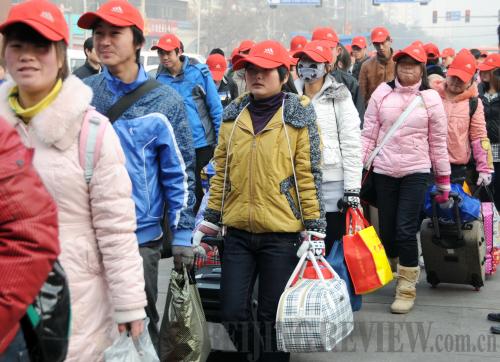|
 |
|
QUEUING FOR HOPE: Young people from northwest China's Gansu Province leave for the jobs provided by eight enterprises in economically developed Jiangsu Province on December 20, 2011 (HUANG WENXIN) |
Apart from the Wuling Mountain project, the Central Government also pledged to set up 10 other trans-provincial poverty-reduction projects, located mainly in mountainous areas in central and western parts of China.
Meanwhile, three special regional projects are targeting regions with concentrated populations of ethnic minorities including Tibet Autonomous Region, Tibetan-populated areas in Sichuan, Yunnan, Gansu and Qinghai provinces and the southern part of Xinjiang Uygur Autonomous Region.
The 14 clustered poverty-stricken areas, which cover a total of 679 counties with a combined population of more than 236 million, will be the main battlefield for the country's poverty alleviation work in the next decade, said Fan with the LGOPAD.
"The idea is both a continuation and an innovation to past working thoughts," Fan said.
According to him, China's poverty-stricken counties are mainly distributed in certain clustered areas, with common characteristics. In the 1980s, the government set up 18 areas as the main targets for special support, but with the change of project emphasis these areas were replaced by key poverty-stricken counties.
After more than two decades of development, there has been significant progress in poverty alleviation. "Although development has been achieved in many of the poverty-stricken counties recognized in the 1980s, a new challenge has appeared—imbalanced development," Fan said.
Huang Chengwei, Deputy Director of the International Poverty Reduction Center in China under the LGOPAD, said that making clustered poverty-stricken areas the main battlefield is an inevitable choice for China's poverty alleviation program in the next decade.
According to Huang, a veteran researcher of the poverty relief system for clustered areas, China's absolute poor population is mainly centered in some clustered mountainous areas, which makes it feasible for the government to implement a highly focused poverty alleviation program.
"The past decade's poverty reduction target has been completed on time. The next step will require more concentrated efforts," Huang said.
Wu Guobao, Director of the Poverty and Development Finance Division at the Rural Development Institute of the CASS, said that the aim of setting up clustered poverty-stricken areas is not only to increase those poor residents' incomes but also to solve the shortage of infrastructure facing these areas.
"Poverty reduction does not only mean providing adequate food and clothing for those in need, it should help assistance recipients live with dignity," said Li Xiaoyun, a rural development expert at Renmin University of China. "In the past, China faced the challenge of widespread absolute poverty. Right now, its main task is to deal with the yawning wealth gap between the rich and the poor."
According to LGOPAD director Fan, the average per-capita income of China's urban residents was 3.23 times that of rural residents in 2010.
"The widening wealth gaps between urban and rural areas, between different regions and between the rich and the poor in China have become a major public concern," Fan said.
"China needs to pay more attention to comparative poverty, which is more serious than absolute poverty because it is a matter of social justice," said Li Shi, a professor of economics at Beijing Normal University. "This requires a change in how we define and understand poverty."
Meanwhile, some rural residents easily fall back into poverty when struck by natural disasters and economic changes.
| 